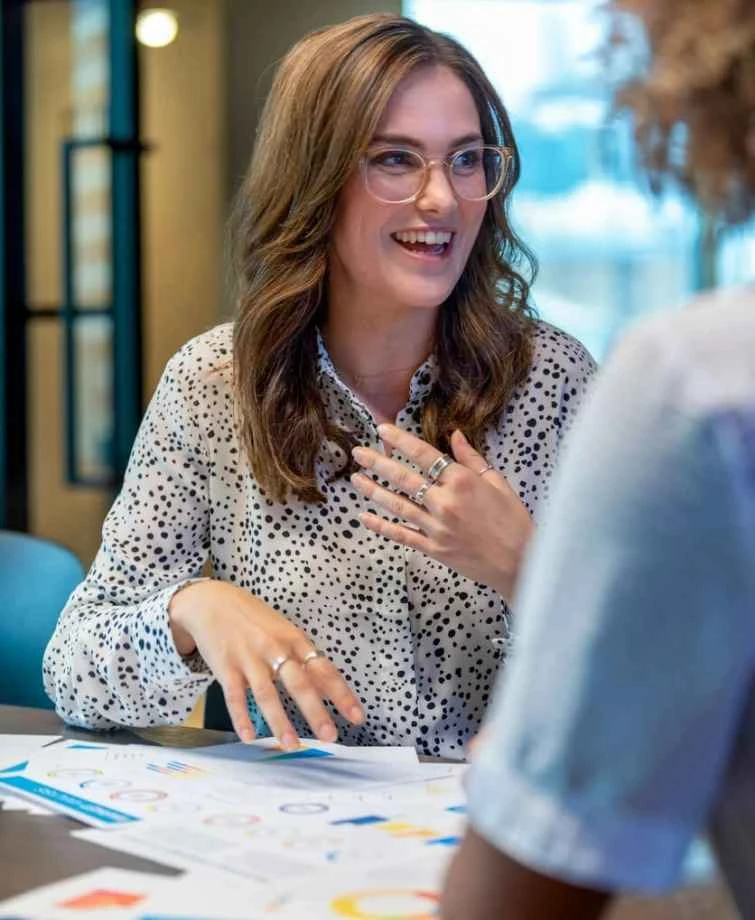IMS Senior Jury Consultant Aref Jabbour, PhD and podcast host Adam Bloomberg discuss the importance of storytelling and effective trial graphics, online and onsite jury research, and mental health in the legal industry. Listen, watch, and/or read the transcript below. (Part 2 of 2)
Hello, and welcome to the IMS Insights Podcast. I’m your host, Adam Bloomberg. Today, we’re speaking with IMS Senior Jury Consultant Dr. Aref Jabbour about visual storytelling, early jury research insights, and the importance of mental health and mentorship in the legal field.
Dr. Jabbour applies clinical psychology and research expertise to numerous cases, including product liability, white-collar crime, toxic tort, catastrophic injury, and complex business litigation. He has published and presented numerous works on jury research, juror perceptions, voir dire strategy, and nuclear verdicts.
Adam Bloomberg:
I wanted to get your thoughts on storytelling. And I think it’s one of the areas where TV is right, with movies and 30-minute shows, it’s always about a good story. These successful trial attorneys that you and I get to work with, they are excellent storytellers. Can you describe the role of storytelling in today’s trials?
Aref Jabbour:
Absolutely. It's an art, and I approach it and I remind attorneys all the time, you know, and you live your cases for years, sometimes. The jurors don't know your cases, and they're going to live your case for maybe two weeks, maybe three weeks, maybe longer in some cases. So, it's incumbent on you and the lawyers to make sure that all, as many, all of the facts, everything fits together in a way that people can repeat to each other and understand. And we all know storytelling has been, it's basically in our DNA, and that's one of the ways that we process information and remember information. So, the trial lawyer that understands their case really well is also the trial lawyer that is able to put the pieces together to convey it to the triers of fact who don't know anything about the case. Oftentimes we have attorneys who say, well if we present all of this information to them, they should understand that we didn't do anything wrong or there's no issue here.
While the converse should be, if we present this universe of information tied together this way, then people will feel empowered that they understand what happened, and that they would feel confident that they understand it happened this way because things unfolded in this process, so on and so forth. And they tie all of the pieces together. That's the critical component. There's a lot of witnesses, there's a lot of evidence, there's a lot of documents, but how do they all tie together, and what's the organizing structure? And that's why we often work with lawyers to say, okay, these pieces and these witnesses fit together when you're discussing this topic, and it relates to this topic and this has this information in it, and it relates to this topic, and so on to the end point of reaching this, the verdict that's favorable and here's why.
Adam Bloomberg:
Do you have any more examples of good storytelling?
Aref Jabbour:
Let’s say even if it's a case that may not be as interesting to people, as in a copyright infringement case, it's not something that's typically portrayed on TV or in the movies. So, what I advise clients is, okay, well let's set up some organizing questions, what this case is about or who knew what, when. And what are the key issues here, and what evidence does the other side have that, why is it that the evidence that the other side has is not relevant or is not critical? And then you present these questions, and you're telling the jurors in the opening statement, we're going to walk through these issues, walk through these questions, and going to explain to you the components of each one. As then we go on, as the evidence unfolds and the arguments unfold and you'll see that the answer to this question should be this, this, and that, and so on and so on and so forth to reach the end point of there is no harm here, no harm done here.
Now what that does, at least in a particular case, like an infringement case where there's a lot of complicated issues, document-intense issues, lots of expert witnesses on both sides, you have to bring people back to what I find useful, these critical questions that they understand. What is this related to? It's related to this question and this issue. What is that related to? It's related to this question and that issue. And as the story unfolds and then people then feel, oh, well I realize that the evidence they're putting is actually completely irrelevant for this infringement matter, and it's actually baseless, and it's actually very unreliable. And they see that and almost, you can see in some people's faces, or hope to see in some people's faces, an “aha” moment where they understand. I feel like I understand what the issues are here. I have a good grasp, and I'm confident in saying that there's no wrongdoing here because the lawyer presented it in a way that empowered me to understand their story and be able to relay it to others.
Adam Bloomberg:
How do visuals play a role in storytelling?
Aref Jabbour:
They're absolutely critical because anybody can put words on a slide and ask people questions. But then if you're presenting complex concepts to them in a visual way, and that's another example, we may have practice visuals, we do mocks or research projects, and we present graphics to jurors. And if they don't portray a particular concept in a simple enough matter, then we learn, we say, we need to simplify this a lot more. Less arrows going different places, less components, maybe less or more animation. So that we learn that to convey these messages truly, they need to understand how it relates to a topic or question, but a graphic representation will add even more to how well they remember that. And that's a critical component of how we relay the words to the graphs to the ultimate arguments that we need the jurors to understand.
Adam Bloomberg:
Yeah, it’s a fine line you’ve got to walk in trial, you know. Your example about intellectual property cases is a great one. Clearly in those cases you’ve got, you know, sometimes really dense topics, patents that you have to show, and how a technology worked and did it, did it not infringe. Or sometimes you have a simple case. You know, you might have just a slide with text – details, credibility, common sense. And maybe sometimes a simple picture works, you know, the iceberg image used by a defense lawyer in opening. You know, plaintiff counsel has just presented their case, but there’s more to the story. You know, we kind of have to figure out how, when, and where to use a visual, but it sure seems like most cases can use a good visual. What about cases where we have disturbing images or videos, and I’m thinking of, let’s say, premise liability cases, an injury, or worse some sort of fatality has happened. How do you advise trial teams to approach showing that to the jury?
Aref Jabbour:
I generally like to tell lawyers that, to reach out to the jury as much as possible, in telling them and asking them that we need their help. We need their help to figure out what happened in this case, because one side thinks one thing, or the other side may think something completely different. And so, in that process, in communicating to the jurors that we are empowering them, to telling them, asking them for their help, asking them for their contributions. We tell them that we need to show them or explain to them the parameters of what happened. And we warn them, or we tell them that there's maybe some things that might be disturbing. But again, in the context of educating them, empowering them, and asking for their help. And in doing that and making sure that they can help us help the lawyers as much as possible, we need to educate them on what happened, where it happened, and how things look.
And if there's particularly disturbing images, then we have to show them as quickly as possible or at least know exactly what needs to be said when something is presented rather than ramble or not know what to say if something up there is put up. But in my opinion, the most important thing is to tell the jurors why the images are being shown, what the purpose of them is, how it would help them to understand the case, and how it would help them to decide the ultimate issues in the favor of our clients.
Adam Bloomberg:
So, let’s shift gears. What are some trends you see coming, relating to jury consulting and how you conduct research projects?
Aref Jabbour:
It’s clear that there's a higher frequency now of projects that are done online. We have the capability to do that. And it gives us, perhaps, it gives more clients more access to do research more frequently; it cuts on costs, and we can still get the same quality of data. And you can actually do these kinds of projects or anticipate or hope that there'll be more research done online earlier in the lifecycle of a matter, rather than for clients and attorneys to think that the research is only going to come when it's trial critical. The trial is looming, for example. So, a trend that I may be pushing for or hoping for is that the paradigm shifts where more attorneys think that jury research is not just mock trials to get ready for trial. It's smaller projects sometimes to inform discovery. Smaller projects sometimes to even inform which questions to ask critical witnesses. That doesn't necessitate a full-blown mock trial, but it does, you can do a smaller focus group and have those more tailored research projects to answer specific questions. And that may generate more work, or it may not. But the goal is you are helping clients to get the feedback that they need to move their case forward even if it's really early on in the process.
Adam Bloomberg:
I wanted to end with just a couple of questions about you. Trial is stressful, we all know. How do you find time to attend to your own mental health needs?
Aref Jabbour:
I am a firm believer that mental health is critically related to physical health. So, I am a very passionate fitness person, working out as much as I can, especially on the road, always have packed stuff in the suitcase or always there. And I'm always making time because if I don't make time, that means I'm not prioritizing my physical and mental health. And it comes with no surprise saying, well if you work out, you'll feel better mentally because of the endorphins. And I'm an absolute believer in that, that and the proper nutrition as well. You don't get sick as much and all that stuff, but at the same time you have to prioritize the time that you take for to be as physically fit as you can.
Because that helps you sleep better when you're on the road, helps you deal with the jet lag, helps you deal with all the travel pressures that you have to deal with because you hope that your body is physically fit to deal with that. And also taking time for yourself, even if you're not traveling, even if you're home with your family, you also take time just for yourself. It's not that taking time for yourself is being around everybody in your family, it's just going somewhere, doing something by yourself so you can rejuvenate and replenish your mental wellbeing well.
Adam Bloomberg:
Well said. My goal is to always to have half of my suitcase completely devoted to workout clothes. Okay, can you talk a little bit about the role mentors have played in your career development?
Aref Jabbour:
Critically, I mean. I think when I first started in this field there was, it was a small company, so there's few people, everybody's busy, but there are a few people who I latched onto and thought I would learn as much as I can from them in terms of how they do things. And I saw their success. But it's also, the other side is they've taken the time, right. There's somebody who's starting out wants to volunteer and say, okay, I'm going to do right or do as much as I can and get the feedback. So, there were a couple of people who gave me the time and were there to give the feedback as much as possible to understand this work, that didn't work, and why, and what the ultimate message you're sending to clients if this looks this way or doesn't look like that. So, I was fortunate to have one or two people, one mostly who was really just, that I'm still friends with and close to. And that informed and built my desire to provide that to others. If somebody wants somebody to help and be mentored and to understand and lend an ear, provide feedback on written product, provide feedback on client communication and client interactions, because that's the only way you're going to learn, by doing, especially in this field, to be able to be exposed to that and to get that feedback in a constructive way.
Adam Bloomberg:
Well thank you so much. You've provided a wealth of knowledge today and I really appreciate you taking time out and thank you again.
Aref Jabbour:
Absolutely. Thank you.
Thank you to Dr. Aref Jabbour for speaking with us today, and a special thanks to our listeners. Please join us next time and subscribe to the IMS Insights Podcast.
IMS has delivered strategic litigation consulting and expert witness services to leading global law firms and Fortune 500 companies for more than 30 years and in more than 40,000 cases. IMS consultants become an extension of your legal team from pre-suit investigation services to discovery and then on to arbitration and trial. Learn more at imslegal.com.
View this content on the National Law Review website: Visual Storytelling & Early Jury Research (natlawreview.com)







